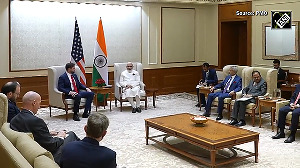The April 17, 50bp CRR hike announcement came as a surprise to many market participants. While there were many who were expecting RBI to respond with such an action, its timing was definitely not anticipated, especially with the Credit Policy announcement just around the corner.
In general, the market has interpreted this as an emergency measure to address the aggravating inflationary scenario.
The surge in inflation rate in the recent months has put renewed focus on monetary policy administration. The headline inflation rate has picked up dramatically in the recent months to little below 7.5 per cent and has come as a surprise also for the RBI.
Not so far back, RBI was expecting inflation to be anchored at 4.5 per cent and about six months back the actual inflation was hovering around 3.5 per cent.
The haste with which the CRR action was initiated leads to some obvious questions. Will the RBI follow up with rate hikes tomorrow? Are we headed for another round of more intense tightening? And the more fundamental question of whether the Monetary Policy measures have become ineffective in attaining price stability.
Looking at the recent history one notes that the ongoing monetary tightening cycle started in October 2004; with initial focus on rate measures (till mid 2006) and later shifting to quantitative measures like increase in CRR rate and tightening of adequacy rates for banks.
Over the entire tightening phase the reverse repo (i.e. the absorption rate) and the repo rate (i.e. the liquidity injection rate) have been increased by 150 bps and 175 bps respectively to 6 per cent and 7.75 per cent respectively.
In comparison, the CRR has increased by 350bps. Including the latest move the CRR has been increased by 200 bps over Mach 2007 while the policy rates have remained unchanged.
It is evident that concerns on inflation has been there for a while and has figured in several forms in RBI's past statements. These included concerns on overheating, concerns on financial stability and quality of credit accumulation.
But despite the concerted efforts, inflationary threats have failed to recede. On the contrary, things have got aggravated and now the RBI is getting increasingly concerned about worsening inflationary expectation.
While it was hoped that the measured monetary steps towards slowing down demand and supply creation emanating from huge capital formation will help bring down inflation, the obtaining situation so far indicate that the objective of price stability has remained elusive.
RBI's manufacturing sector survey tends to suggest that despite the mild slowdown that we have seen in the recent quarters, the capacity prevailing and expected utilization level for the manufacturing sector have remained high around, which indicates continued supply constraints.
Possibly, the capacity creation in general has yet to materialize or the demand pressures have continued to overweigh.
A significant reason for the ineffectiveness of both fiscal and monetary measures has been the fact that the demand and supply pressures we have is not just local but also global. This is evident from similarity of inflationary concerns faced by most emerging market economies. Even in advanced economies, despite the slowdown threat, inflation continues to remain above comfort levels.
It's a common believe today that the current inflation is supply shock driven and hence, monetary measures may not be effective. Hence, RBI should refrain from tightening. Some have argued that a more aggressive strategy towards easing supply bottlenecks will possibly address the problem better. There are also views around banning futures trading in commodities market to prevent speculative demand.
In my view, the scenario may be somewhere in between. Supply constraints have build up only because of continued demand pressure. Price escalations have happened over a period of several years and hence, cannot be termed as a shock. A large part of agro product price rise can be attributed to increasing trend towards conversion of agro commodities into bio-fuel, which has been catalysed by high fuel prices.
Since there is a significant contribution from the demand side, it will be incorrect to hypothesize irrelevance of monetary measures. In fact most other emerging central banks have deployed monetary tightening measures to control inflation. The common course of action is to moderate demand and credit flows. These are coupled with measures to ease supply bottleneck.
Whether, this will translate into any immediate moderation in inflationary pressures is questionable. Even while there has been containment of credit growth in India, slowing of demand pressures has been moderate. Supply side mismatch is unlikely to ease in the near term given the structural nature some of the factors have attained.
So while the options available to attain price stability is limited and the RBI is likely to hold on to a tight monetary stance. But the possibility of policy rate (repo and reverse repo rate) hikes is low given that it impacts most sectors uniformly, which RBI is getting increasingly sensitive about.
The recent CRR rate hike move suggests that RBI will continue to rely more of quantitative measures with a focus on managing liquidity, also through other instruments such as LAF and open market operation.
While past measures have successfully slowed credit growth, money supply growth has continued to remain above target. Hence, there will likely be renewed focus on slowing money supply.
Use of exchange rate appreciation as a policy tool to contain inflation may not be a plausible option at the moment as the balance of risk does not seem to support any significant rupee appreciation. Raising rates to enable such a scenario is froth with the risk of further aggravating the liquidity management problems.
To conclude, I believe that while it might be inappropriate to conjecture that monetary measures are ineffective, it will not be incorrect to say that in the current scenario, the transmission of monetary signals towards impacting inflation has weakened due to underlying factors attaining global dimensions.
The current situation requires coordinated and concerted efforts by major global central banks and governments, specially in the emerging markets to attain price stability, much akin to the efforts made by the Fed, the ECB and Bank of England to attain financial stability through liquidity infusion measures.
Attainment of growth and price stability through isolated measures by RBI may not be the most effective way.
The author is strategist and economist, Centrum Broking. The views expressed are personal.







 © 2025
© 2025